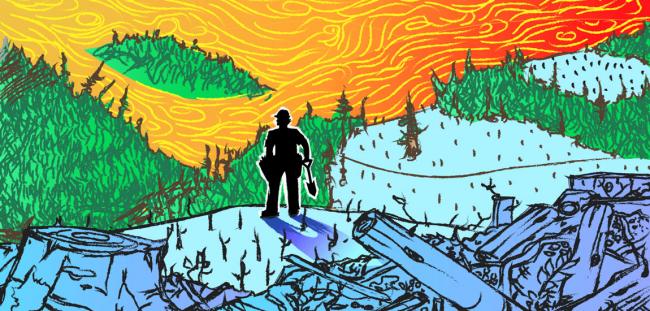Articles Menu

Jun. 17, 2022
Standing in a vast clearcut in British Columbia feels strangely dystopian. It’s quiet. There are no leaves to rustle, no bushes for animals to hide behind. The sun beats down and, you soon discover, there are no trees for shade.
Slash piles are your landmarks now — those mountains of branches leftover from logging. Come winter they’ll get burned. Bonfires against the snow, like a scene from Game of Thrones.
For most planters in Canada, the season begins in late April or early May with snow and hail and spindly spring trees. By July, it’s black flies and summer trees — bigger and heavier than their over-wintered cousins.
I spent a lot of time in clearcuts last summer. By the end of the three months, I’d planted 41,520 trees. Getting paid per tree makes planting a numbers game. How many seconds per tree? How many trees per day? Ask a planter their personal best and they’ll rattle off a figure in the thousands. This surprises people. But we’re planting seedlings, not saplings. To give you an idea, picture a stumpy brown carrot with the leafy stems attached.
Of those 41,520 trees, roughly half will have died in the ‘one-in-a-thousand-year’ heatdome. That’s according to our company checker, whose job it was to inspect the trees. Some of those were planted as part of the federal government’s two billion trees pledge. How many of those survived?
Across the province and even into northern Alberta, the mortality rate was estimated at 25 per cent [1]. That means, of the more than 400 million seedlings planted in Western Canada that year, around a hundred million may have died in the extreme heat.
And what of the remaining trees? Well, most will supply the lumber companies that paid for the planting.
“Planting and logging, it’s two sides of the same coin,” says Eric Wright, Ecojustice communications manager and a B.C. planter for six seasons. Wright, who quit planting due to its intense labour conditions, says, “Tree planting, as we know it in Canada, is focused on growing future commodities for harvest — not restoring forests, ecosystems, or biodiversity.”
Which, from an economic standpoint, makes sense. Each year, professional planters throughout Canada put nearly 700 million trees in the ground [2]. The majority of these are fast-growing commercial species like Douglas fir or lodgepole pine. Logging companies, under legal obligations to reforest their clear-cuts turn thriving, biodiverse areas into so-called ‘green deserts’.
Here in B.C., they’re doing this to old-growth forests too.
It might seem obvious, but you can’t cut down trees which have stood for hundreds of years and then claim it’s sustainable. Yet, that’s exactly what the Canadian Standards Association (CSA) has been doing since 1996.
In July 2021, on behalf of six signatories and supported by Stand.earth and Ancient Forest Alliance, Ecojustice filed a complaint to the federal Competition Bureau asking it to investigate the CSA’s Sustainable Forestry Management standard certification. Why? Because a sustainability standard with no standards is a scam.
The Bureau is now moving forward with the investigation.
If you’re planting native species in your backyard, go right ahead (and thank you). That’s worlds away from the type of planting that led to this article. The point is that not all trees are equal; a seedling planted today will always be a poor substitute for an 800-year-old tree.
But the idea of planting trees is popular. That’s why politicians make pledges and why companies promise trees with each purchase. After all, who doesn’t love trees?
The problem is when we see mass planting as a cure-all for climate chaos. It overlooks the vital work needed to reduce greenhouse gas emissions and restore current ecosystems. For instance, existing forests not only provide homes for wildlife, they also store carbon, clean the air and water, prevent flooding, and cool the area — all of which we need as we face the dual climate and ecological crises.
We need to debunk the idea that we can pay our way out of this mess. Or else fossil fuel companies can keep claiming to do their part by funding “the world’s largest protected area of boreal forest.”
Instead, our leaders should take their cue from those who’ve looked after the lands and waters for thousands of years. Around the world, Indigenous Peoples make up about 6 per cent of the population and still they protect 80 per cent of the biodiversity left on Earth. Any ‘climate solution’ that ignores Indigenous voices, sovereignty or stewardship is a death sentence for the planet, delivered by those who see nature as ‘natural resources’…and forests as nothing more than factories for trees.
[1] State of the industry, fall 2021 (BC tree planting)
[2] How many trees are planted in Canada each year?
[Top: Illustration: Simone Williamson / Ecojustice]